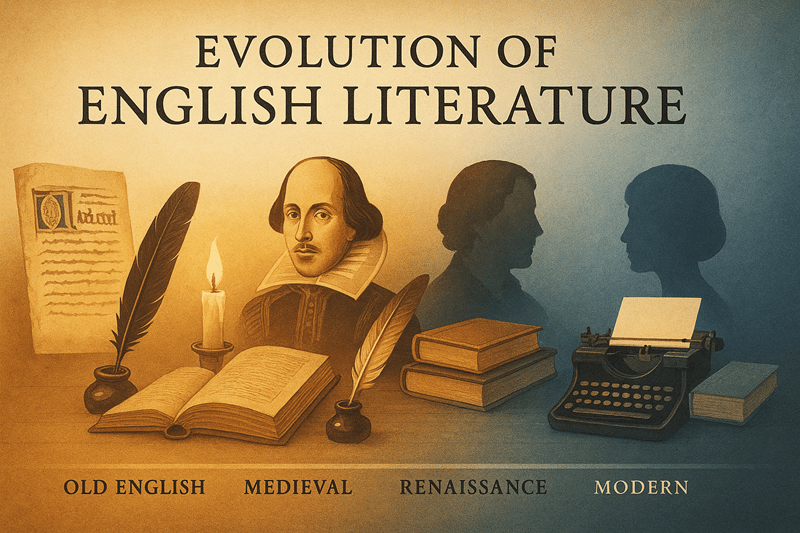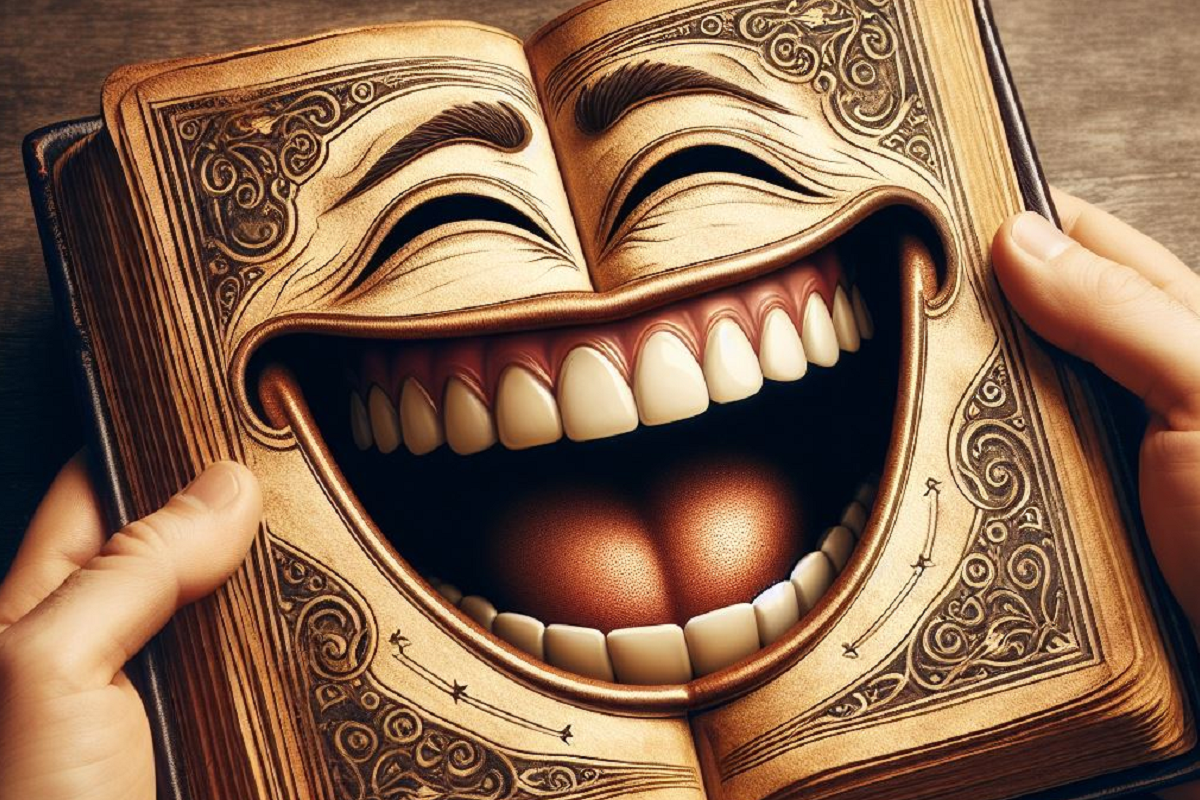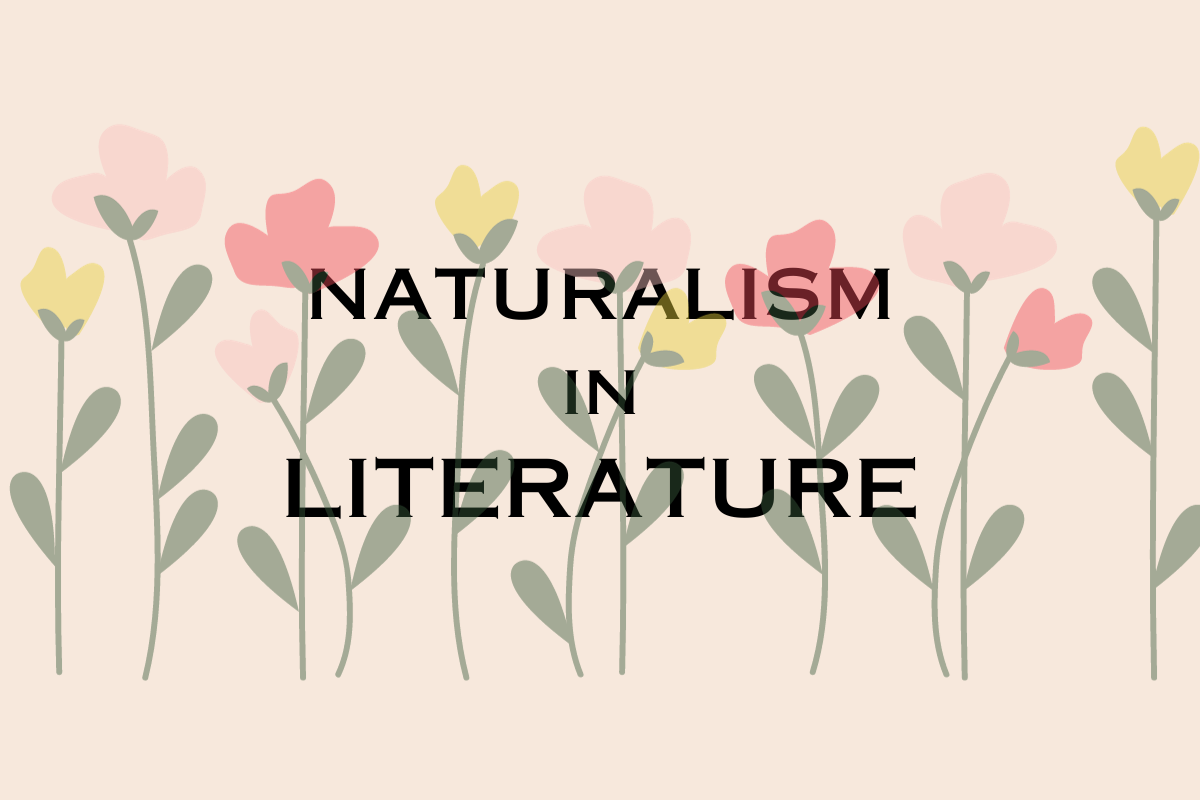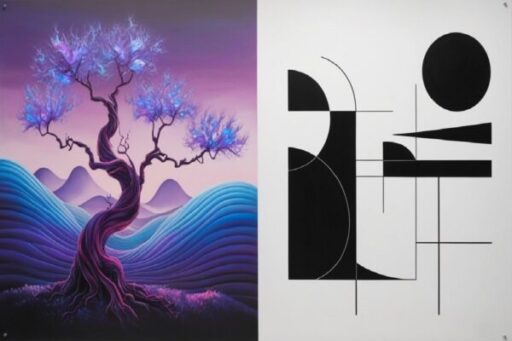We know that literature is a vibrant tapestry woven from words and emotions. It has served as a mirror reflecting the ever-changing human experience. Across millennia, it has evolved from oral traditions to digital narratives, documenting our triumphs and struggles, fears and aspirations. This essay delves into the fascinating evolution of English literature.

Evolution or Ages of English Literature
The earliest forms of literature predate written language itself. Stories were passed down through oral traditions, chanted around campfires, and etched into the collective memory.
These tales are often mythical or allegorical. They served to explain the world, entertain, and transmit cultural values. With the arrival of written language, literature transitioned from fleeting whispers to permanent records. Let’s dive into the amazing evolution of English literature.
1. Anglo-Saxon Period (450–1066 AD)
The earliest known works of English literature were written in Anglo-Saxon, a Germanic language brought to Britain by invading tribes. These works, such as the epic poem Beowulf, often celebrated heroism, loyalty, and the struggles of warriors.
2. Mediaeval Period (1066–1485 AD)
The Norman Conquest of England in 1066 AD brought French influences to the English language. During this period, literature flourished in the form of chivalric romances, religious writings, and morality plays.
Geoffrey Chaucer is considered the father of English literature. He wrote The Canterbury Tales, a collection of stories told by pilgrims travelling to Canterbury Cathedral.
3. The Renaissance (14th–17th Centuries)
The Renaissance is a period of cultural rebirth. It saw a renewed interest in classical texts and a focus on humanism. Writers like William Shakespeare and Christopher Marlowe explored themes of love, loss, ambition, and the complexities of human nature.
Shakespeare’s timeless plays, such as Hamlet, Romeo and Juliet, and Macbeth, continue to be performed and studied worldwide.
Recommended: The Evolution of Humor in Literature: From Chaucer to Modern Day
4. The Enlightenment (17th–18th Centuries)
The Enlightenment ushered in a focus on reason and logic. Writers like Voltaire and Mary Wollstonecraft used literature to critique societal injustices and advocate for social reform. Novels gained prominence during this period, allowing writers to explore complex social issues and individual experiences in greater depth.
5. Romanticism (18th–19th Centuries)
In contrast to the Enlightenment’s emphasis on reason, Romanticism celebrated emotion, imagination, and the beauty of nature. William Wordsworth, Samuel Taylor Coleridge, John Keats, and Lord Byron were some of the leading figures of this movement. Their poems explored themes of individual experience, introspection, and the sublime.
6. Victorian Era (1837–1901)
The Victorian Era saw the rise of the novel as a dominant literary form. Charles Dickens, Jane Austen, and the Brontë sisters (Charlotte, Emily, and Anne) painted vivid portraits of Victorian society. They explored themes of social class, gender roles, and the human condition.
7. Modernism (Early 20th Century)
Modernism is a reaction to the traditional forms of the past. It experimented with narrative structure, language, and form. Writers like Virginia Woolf, James Joyce, and T.S. Eliot used stream-of-consciousness techniques and fragmented narratives to explore the complexities of modern life and the alienation of the individual.
8. Postmodernism (Mid-20th Century to Present)
Postmodernism challenged the grand narratives and universal truths of modernism. Writers like Salman Rushdie, Toni Morrison, and Margaret Atwood blurred the lines between genre, reality, and fantasy, often incorporating elements of metafiction and magical realism.
Recommended: Realism vs Surrealism in Literature: A Comparative Study
9. The Digital Age and the Future of Literature
The digital age has brought about new forms of storytelling, with the rise of e-books, online fiction, and interactive narratives. The future of literature remains exciting, with new technologies potentially transforming the way we read, write, and experience stories.
Key Phases of Literature: A Journey Through Genres and Styles
The evolution of English literature has branched out into a diverse array of genres, each with its own unique conventions and characteristics.
1. Poetry
The earliest form of literature is poetry. It uses rhythm, rhyme, and metre to evoke emotions and inspire contemplation. From the epic sagas of Homer to the evocative sonnets of William Butler Yeats, poetry continues to occupy a cherished place in the literary landscape.
2. Drama
Designed to be performed on stage, drama allows audiences to experience stories firsthand. The tragedies of Sophocles and Shakespeare, the comedies of Molière and Oscar Wilde, and the absurdist works of Samuel Beckett showcase the power of drama to move, entertain, and challenge.
3. Fiction
Prose narrative tells stories. Fiction allows writers to create imaginary worlds and characters. From the fantastical adventures of J.R.R. Tolkien to the gritty realism of Charles Dickens, fiction offers a window into diverse human experiences.
4. Non-fiction
Factual prose explores a wide range of topics, whereas non-fiction encompasses everything from historical accounts to scientific treatises to personal essays.
Recommended: Are There Any Hidden Meanings in The Wonderful Wizard of Oz Book?
Famous Authors and Their Literary Footprints
The literary world boasts a rich tapestry of iconic authors, each contributing to its evolution.
1. Jane Austen
Jane Austen is a prominent figure in the English Romantic era. His witty social satires like Pride and Prejudice and Sense and Sensibility explored themes of class, gender roles, and love in 19th-century England.
2. Leo Tolstoy
A master of psychological realism, Leo Tolstoy’s epic novels like War and Peace and Anna Karenina offered profound insights into human nature, love, and the complexities of Russian society.
3. Gabriel García Márquez
Gabriel García Márquez is one of the founders of magical realism. It is a genre that blends fantasy with reality. His masterpiece titled One Hundred Years of Solitude delves into the history and mythology of Colombia.
4. Toni Morrison
Toni Morrison is a Nobel Prize-winning author. His powerful novels like Beloved and The Bluest Eye explored the African American experience in the United States, addressing themes of racism, identity, and memory.
Author’s Evolution: A Reflection of the Times
How has the role of the author evolved in English literature? Writers are not immune to the influence of their time period. Their evolving worldviews, historical contexts, and technological advancements shape their work in evolution of English literature.
Writing in the midst of the Industrial Revolution, Charles Dickens addressed social injustices and the plight of the working class in novels like Oliver Twist and Hard Times.
In contrast, authors like Virginia Woolf and James Joyce wrote during a period of rapid societal change and experimentation. They embraced modernist techniques like stream-of-consciousness and fragmented narratives, as seen in Woolf’s Mrs. Dalloway and Joyce’s Ulysses.
Books that Show Evolution: A Testament to Change
Several literary works explicitly showcase the evolution of society and its impact on English literature. Apart from the books mentioned above, we have listed a few more that impacted the evolution of English literature.
1. To Kill a Mockingbird by Harper Lee (1960)
Set in the racially charged American South of the 1930s, this novel explores themes of racial prejudice, innocence lost, and the power of compassion. Lee’s work reflects the growing awareness of civil rights issues during the mid-20th century.
2. 1984 by George Orwell (1949)
This dystopian novel paints a chilling portrait of a totalitarian future where individuality is suppressed and thought is controlled. Reflecting the anxieties of the Cold War era, 1984 critiques the dangers of unchecked government power and political manipulation.
3. Fahrenheit 451 by Ray Bradbury (1953)
It is set in a future where books are banned and firefighters burn them instead of extinguishing fires. This novel explores themes of censorship, the power of knowledge, and the importance of critical thinking. Bradbury’s work resonates with concerns about the rise of mass media and the potential for information control.
4. The Handmaid’s Tale by Margaret Atwood (1985)
This dystopian novel depicts a future where women are subjugated and forced into reproductive servitude. Atwood’s work serves as a potent critique of patriarchal oppression and a call for women’s rights in a world grappling with changing gender roles.
Recommended: Essential Tips to Read War and Peace: A Guide to Enjoying Tolstoy’s Masterpiece
Conclusion: A River of Words Flowing Through Time
Literature is like a river that flows through time. It constantly evolves and adapts to the changing world around it. From the campfire tales of our ancestors to the digital narratives of today, English literature continues to offer a window into the human experience, and its evolution captures our hopes and fears, dreams and struggles.



